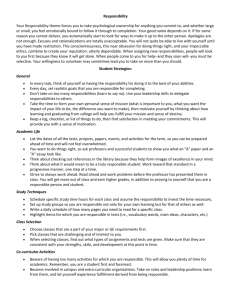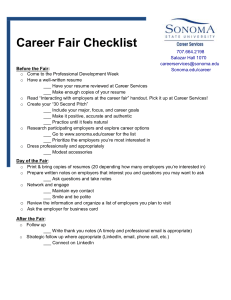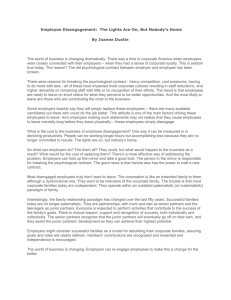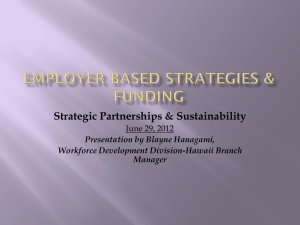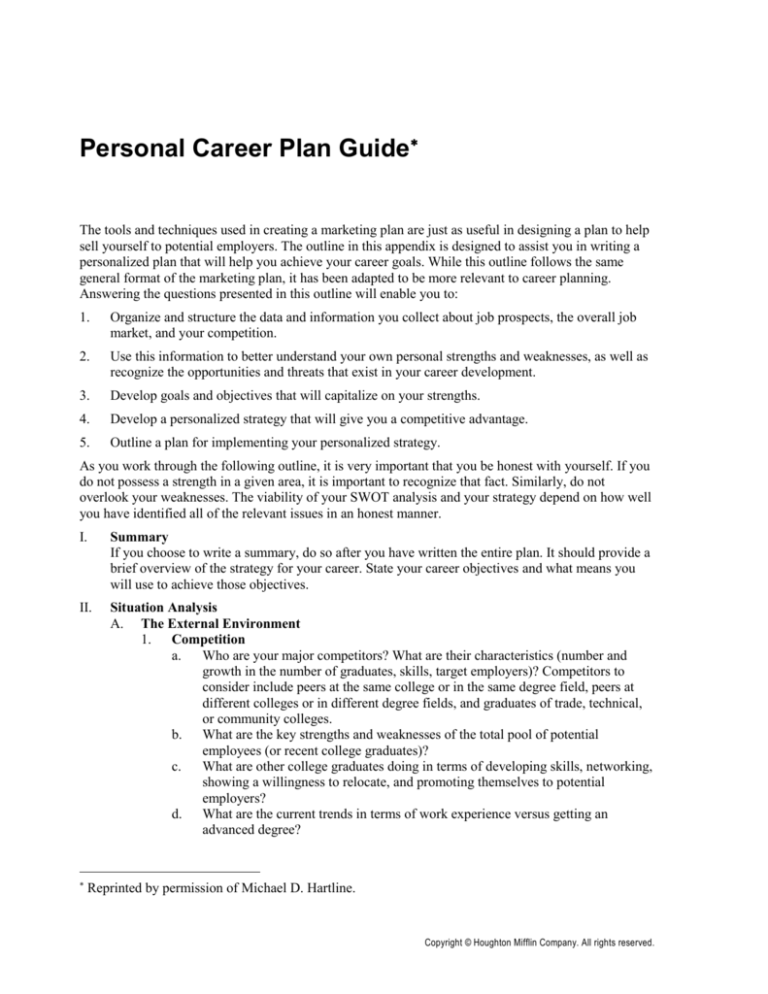
Personal Career Plan Guide
The tools and techniques used in creating a marketing plan are just as useful in designing a plan to help
sell yourself to potential employers. The outline in this appendix is designed to assist you in writing a
personalized plan that will help you achieve your career goals. While this outline follows the same
general format of the marketing plan, it has been adapted to be more relevant to career planning.
Answering the questions presented in this outline will enable you to:
1.
Organize and structure the data and information you collect about job prospects, the overall job
market, and your competition.
2.
Use this information to better understand your own personal strengths and weaknesses, as well as
recognize the opportunities and threats that exist in your career development.
3.
Develop goals and objectives that will capitalize on your strengths.
4.
Develop a personalized strategy that will give you a competitive advantage.
5.
Outline a plan for implementing your personalized strategy.
As you work through the following outline, it is very important that you be honest with yourself. If you
do not possess a strength in a given area, it is important to recognize that fact. Similarly, do not
overlook your weaknesses. The viability of your SWOT analysis and your strategy depend on how well
you have identified all of the relevant issues in an honest manner.
I.
Summary
If you choose to write a summary, do so after you have written the entire plan. It should provide a
brief overview of the strategy for your career. State your career objectives and what means you
will use to achieve those objectives.
II.
Situation Analysis
A. The External Environment
1. Competition
a.
Who are your major competitors? What are their characteristics (number and
growth in the number of graduates, skills, target employers)? Competitors to
consider include peers at the same college or in the same degree field, peers at
different colleges or in different degree fields, and graduates of trade, technical,
or community colleges.
b. What are the key strengths and weaknesses of the total pool of potential
employees (or recent college graduates)?
c.
What are other college graduates doing in terms of developing skills, networking,
showing a willingness to relocate, and promoting themselves to potential
employers?
d. What are the current trends in terms of work experience versus getting an
advanced degree?
Reprinted by permission of Michael D. Hartline.
Copyright © Houghton Mifflin Company. All rights reserved.
Appendix B: Personal Career Plan Guide
e.
B.
269
Is your competitive set likely to change in the future? If so, how? Who are these
new competitors likely to be?
2. Economic conditions
a.
What are the general economic conditions of the country, region, state, and local
area in which you live or in which you want to relocate?
b. Overall, are potential employers optimistic or pessimistic about the economy?
c.
What is the overall outlook for major job/career categories? Where do potential
employers seem to be placing their recruitment and hiring emphasis?
d. What is the trend in terms of starting salaries for major job/career categories?
3. Political trends
a.
Have recent elections changed the political landscape so that certain industries or
companies are now more or less attractive as potential employers?
4. Legal and regulatory factors
a.
What changes in international, federal, state, or local laws and regulations are
being proposed that would affect your job/career prospects?
b. Have recent court decisions made it easier or harder for you to find employment?
c.
Have global trade agreements changed in any way that makes certain industries
or companies more or less attractive as potential employers?
5. Changes in technology
a.
What impact has changing technology had on potential employers in terms of
their need for employees?
b. What technological changes will affect the way you will have to work and
compete for employment in the future?
c.
What technological changes will affect the way you market your skills and
abilities to potential employers?
d. How do technological advances threaten to make your skills and abilities
obsolete?
6. Cultural trends
a.
How are society’s demographics and values changing? What effect will these
changes have on your:
(1). Skills and abilities
(2). Career/lifestyle choices
(3). Ability to market yourself
(4). Willingness to relocate
(5). Required minimum salary
b. What problems or opportunities are being created by changes in the cultural
diversity of the labor pool and the requirements of potential employers?
c.
What is the general attitude of society regarding the particular skills, abilities, and
talents that you possess and the career/lifestyle choices that you have made?
The Employer Environment
1. Who are your potential employers?
a.
Identifying characteristics: industry, products, size, growth, profitability, hiring
practices, union/non-union, employee needs, etc.
b. Geographic characteristics: home office, local offices, global sites, expansion,
etc.
c.
Organizational culture: mission statement, values, priorities, employee training,
etc.
d. In each organization, who is responsible for recruiting and selecting new
employees?
2. What do your potential employers look for in new employees?
Copyright © Houghton Mifflin Company. All rights reserved.
270
Appendix B: Personal Career Plan Guide
a.
C.
What are the basic or specific skills and abilities that employers are looking for in
new employees?
b. What are the basic or specific needs that are fulfilled by the skills and abilities
that you currently possess and that other potential employees currently possess?
c.
How well do your skills and abilities (and those of your competitors) currently
meet the needs of potential employers?
d. How are the needs of potential employers expected to change in the future?
3. What are the recent hiring practices of your potential employers?
a.
How many employees are being hired? What combination of skills and abilities
do these new hires possess?
b. Is the growth or decline in hiring related to the recent expansion or downsizing of
markets and/or territories? Changes in technology?
c.
Are there major hiring differences between large and small companies? If so,
why?
4. Where and how do your potential employers recruit new employees?
a.
Where do employers make contact with potential employees?
(1). College placement offices
(2). Job/career fairs
(3). Internship programs
(4). Headhunting firms
(5). Unsolicited applications
(6). The Internet
b. Do potential employers place a premium on experience or are they willing to hire
new graduates without experience?
5. When do your potential employers recruit new employees?
a.
Does recruiting follow a seasonal pattern or do employers recruit new employees
on an ongoing basis?
Personal Assessment
1. Review of personal goals, objectives, and performance
a.
What are your personal goals and objectives in terms of employment, career,
lifestyle, geographic preferences, etc.?
b. Are your personal goals and objectives consistent with the realities of the labor
market? Why or why not?
c.
Are your personal goals and objectives consistent with recent changes in the
external or employer environments? Why or why not?
d. How are your current strategies for success working in areas such as course
performance, internships, networking, job leads, career development,
interviewing skills, etc.?
e.
How does your current performance compare to that of your peers (competitors)?
Are they performing well in terms of course performance, internships,
networking, job leads, career development, interviewing skills, etc.?
f.
If your performance is declining, what is the most likely cause?
g. If your performance is improving, what actions can you take to ensure that your
performance continues in this direction?
2. Inventory of personal skills and resources
a.
What do you consider to be your marketable skills? This list should be as
comprehensive as possible and include areas such as interpersonal skills,
organizational skills, technological skills, communication skills (oral and
written), networking/team-building skills, etc.
b. Considering the current and future needs of your potential employers, what
important skills are you lacking?
Copyright © Houghton Mifflin Company. All rights reserved.
Appendix B: Personal Career Plan Guide
c.
271
Other than personal skills, what do you consider to be your other careerenhancing resources? This list should be as comprehensive as possible and
include areas such as financial resources (to pay for additional training, if
necessary), personal contacts or “connections” with individuals who can assist
your career development, specific degrees or certificates you hold, and intangible
resources (family name, prestige of your educational institution, etc.).
d. Considering the current and future needs of your potential employers, what
important resources are you lacking?
III. SWOT Analysis (your personal strengths and weaknesses and the opportunities and threats
that may impact your career)
A. Personal Strengths
1. Three key strengths
a.
Strength 1
b. Strength 2
c.
Strength 3
2. How do these strengths allow you to meet the needs of your potential employers?
3. How do these strengths compare to those of your peers/competitors? Do these
strengths give you an advantage relative to your peers/competitors?
B. Personal Weaknesses
1. Three key weaknesses
a.
Weakness 1
b. Weakness 2
c.
Weakness 3
2. How do these weaknesses cause you to fall short of meeting the needs of your potential
employers?
3. How do these weaknesses compare to those of your peers/competitors? Do these
weaknesses put you at a disadvantage relative to your peers/competitors?
C. Career Opportunities
1. Three key career opportunities
a.
Opportunity 1
b. Opportunity 2
c.
Opportunity 3
2. How are these opportunities related to serving the needs of your potential employers?
3. What actions must be taken to capitalize on these opportunities in the short-term? In
the long-term?
D. Career Threats
1. Three key career threats
a.
Threat 1
b. Threat 2
c.
Threat 3
2. How are these threats related to serving the needs of your potential employers?
3. What actions must be taken to prevent these threats from limiting your capabilities in
the short-term? In the long-term?
E. The SWOT Matrix
F. Matching, Converting, Minimizing, and Avoiding Strategies
1. How can you match your strengths to your opportunities to better serve the needs of
your potential employers?
2. How can you convert your weaknesses into strengths?
3. How can you convert your threats into opportunities?
4. How can you minimize or avoid those weaknesses and threats that cannot be converted
successfully?
Copyright © Houghton Mifflin Company. All rights reserved.
272
Appendix B: Personal Career Plan Guide
IV. Resources
A. Financial
1. Do you have the financial resources necessary to undertake and successfully complete
this plan (i.e., preparation/duplication/mailing of a résumé, interviewing costs,
including proper attire, etc.)?
B. Human
1. Is the industry in which you are interested currently hiring? Are companies in your
area currently hiring?
C. Experience and Expertise
1. Do you have experience from either part-time or summer employment that could prove
useful in your current plan?
2. Do you have the required expertise or skills to qualify for a job in your desired field? If
not, do you have the resources to obtain them?
V. Strategies
A. Objective(s)
1. Potential employer A
a.
Descriptive characteristics
b. Geographic locations
c.
Culture/values/mission
d. Basic employee needs
e.
Recruiting/hiring practices
f.
Employee training/compensation practices
g. Justification for selection
2. Potential employer B
a.
Descriptive characteristics
b. Geographic locations
c.
Culture/values/mission
d. Basic employee needs
e.
Recruiting/hiring practices
f.
Employee training/compensation practices
g. Justification for selection
B. Strategy(ies) for Using Capabilities and Resources
1. Strategy A (to meet the needs of potential employer A)
a.
Personal skills, abilities, and resources
(1). Description of your skills and abilities
(2). Specific employer needs that your skills/abilities can fulfill
(3). Differentiation relative to peers/competitors (why should you be hired?)
(4). Additional resources that you have to offer
(5). Needed or expected starting salary
(6). Expected employee benefits
(7). Additional employer-paid training that you require
(8). Willingness to relocate
(9). Geographic areas to target
(10). Corporate divisions or offices to target
(11). Summary of overall strategy
(12). Tactics for standing out among the crowd of potential employees
(13). Point of contact with potential employer
(14). Specific elements
(i). Résumé
(ii). Internships
(iii). Placement offices
Copyright © Houghton Mifflin Company. All rights reserved.
Appendix B: Personal Career Plan Guide
273
(iv). Job fairs
(v). Personal contacts
(vi). Unsolicited
(15). Specific objectives and budget
2. Strategy B (to meet the needs of potential employer B)
a.
Personal skills, abilities, and resources
(1). Description of your skills and abilities
(2). Specific employer needs that your skills/abilities can fulfill
(3). Differentiation relative to peers/competitors (why should you be hired?)
(4). Additional resources that you have to offer
(5). Needed or expected starting salary
(6). Expected employee benefits
(7). Additional employer-paid training that you require
(8). Willingness to relocate
(9). Geographic areas to target
(10). Corporate divisions or offices to target
(11). Summary of overall strategy
(12). Tactics for standing out among the crowd of potential employees
(13). Point of contact with potential employer
(14). Specific elements
(i). Résumé
(ii). Internships
(iii). Placement offices
(iv). Job fairs
(v). Personal contacts
(vi). Unsolicited
(15). Specific objectives and budget
C. Strategy Summary
1. How does strategy A (B) give you a competitive advantage in serving the needs of
potential employer A (B)?
2. Is this competitive advantage sustainable? Why or why not?
VI. Financial Projections and Budgets
A. Do you have a clear idea of your budgetary requirements (e.g., housing, furnishings,
clothing, transportation, food, other living expenses)?
B. Will the expected salaries/benefits from potential employers meet these requirements? If not,
do you have an alternative plan (i.e., a different job choice, a second job, requesting a higher
salary)?
VII. Controls and Evaluation
A. Performance Standards
1. What do you have to offer?
Corrective actions that can be taken if your skills, abilities, and resources do not match
the needs of potential employers
2.
Are you worth it?
Corrective actions that can be taken if potential employers do not think your
skills/abilities are worth your asking price
3.
Where do you want to go?
Corrective actions that can be taken if potential employers do not offer you a position
in a preferred geographic location
4.
How will you stand out among the crowd?
Copyright © Houghton Mifflin Company. All rights reserved.
274
Appendix B: Personal Career Plan Guide
Corrective actions that can be taken if your message is not being heard by potential
employers or is not reaching the right people
B.
C.
Monitoring Procedures
1. What types and levels of formal control mechanisms are in place to ensure the proper
implementation of your plan?
a.
Are your potential employers hiring?
b. Do you need additional training/education?
c.
Have you allocated sufficient time to your career development?
d. Are your investments in career development adequate?
(1). Training/education
(2). Networking/making contacts
(3). Wardrobe/clothing
(4). Development of interviewing skills
e.
Have you done your homework on potential employers?
f.
Have you been involved in an internship program?
g. Have you attended job/career fairs?
h. Are you using the resources of your placement center?
i.
Are you committed to your career development?
Performance Analysis
1. Number/quality/potential of all job contacts made
2. Number of job/career fairs attended and quality of the job leads generated
3. Number of résumés distributed
a.
Number of potential employers who responded
b. Number of negative responses
4. Number of personal interviews
5. Number/quality of job offers
Copyright © Houghton Mifflin Company. All rights reserved.


